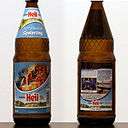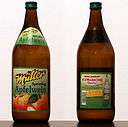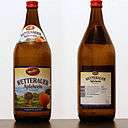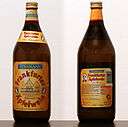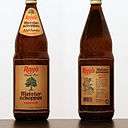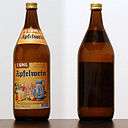
Apfelwein with Bembel
Apfelwein (Germany, apple wine),[1][2] or Most (Austria, Switzerland, South Germany, must) are German words for cider.[3] It is mainly made from eating apples or cooking apples, such as Granny Smith or Bramley, respectively. It has an alcohol content of 4.8%–7.0% and a tart, sour taste.
Apfelwein is also regionally known as Ebbelwoi, Äppler, Stöffsche, Apfelmost (apple must), Viez (from Latin vice, the second or substitute wine), and saurer Most (sour must). The name Äppler, mainly used by large producers, is generally not used in restaurants or by smaller manufacturers who instead call the beverage Schoppen or Schoppe, which refers to the measure of the glass.
In the Frankfurt area, berries from the service tree (Sorbus domestica), are added in bags to increase astringency,[4] this specific type of Apfelwein is called Speierling.
Production
Apfelwein is made from pressed apples. The juice or must is fermented with yeast to produce an alcoholic beverage usually around 6% abv. It can be made with the addition of the unprocessed juice from the fruit of a small, indigenous tree known as Speierling (Sorbus domestica) or Speyerling, an endangered species that is easily confused with the wild apple.
Apfelwein is mainly produced and consumed in Hesse (where it is the state beverage), particularly in the Frankfurt, Wetterau, and Odenwald areas. It is also found in Moselfranken, Merzig (Saarland), and the Trier area, as well as the lower Saar area and the region bordering on Luxembourg. Several large producers are located in these regions, as well as numerous small, private producers which use traditional recipes. Some of the most famous restaurants where Apfelwein is served are in Sachsenhausen (Frankfurt am Main). Some of these regions have regular cider competitions and fairs, in which the small, private producers participate. Cider songs are composed and sung at these events. The Merzig region crowns a "Viez Queen", and the lower Saar area a "Viez King".
Culture

Cider-making equipment on display along Viezstraße

Viezstraße road sign
Apfelwein is served in a Geripptes, a glass with a lozenge cut that refracts light and improves grip—a holdover from the past, when some meals were traditionally eaten without cutlery.[5] Traditional Apfelwein restaurants serve a "proper" 0.30-litre (10-oz) serving, although some establishments may also have a 0.25-l or 0.50-l version of the glass.[6] A Geripptes filled with Apfelwein is also called a Schoppen.
Most establishments also serve Apfelwein by the Bembel (a specific Apfelwein jug), much like how beer can be purchased by the pitcher in many countries. The paunchy Bembel (made from salt-glazed stoneware) usually has a basic grey colour with blue-painted detailing. In the Eifel region, near Hunsrück, around Moseltal, along the lower Saar and in Trier, the drinking container is called Viezporz and consists of white porcelain or stoneware.
Hot Apfelwein is commonly taken as an old household remedy against colds, or as a warming beverage in the cold season. The Apfelwein is heated and served with a cinnamon stick, possibly with cloves and/or a slice of lemon.
An official Viez route, (Route du Cidre) connects Saarburg with the border to Luxembourg. An annual Viez Fest is celebrated in Merzig. The date is usually the second Saturday in October.
Commercial Varieties
| Examples of commercial apfelweins sold in Germany |
|---|
| Heil Eschbacher Traditions Apfelwein |
| Höhl Der alte Hochstädter Speyerling Apfelwein |
| Kelterei Heil Apfelwein Speierlinge |
| Müller Speierling Apfelwein |
| Müller Wetterauer Apfelwein |
| Possmann Frankfurter Apfelwein |
| Possmann Frau Rauscher Speierling |
| Rapp's Meisterschoppen Naturtrüb |
| Rapp's Wetterauer Gold Apfelwein |
|
See also
References
External links
|
|---|
|
| History and production |
|---|
| | History of alcohol | | |
|---|
| | Production | |
|---|
|
|
|
|
|
|
|
Liqueurs and infused distilled beverages by ingredients |
|---|
| |
|
|
-
 Category Category
-
 Portals Portals
- Liquor
- Beer
- Drink
- Wine
-
 WikiProjects WikiProjects
- Beer
- Spirits
- Wine
|




